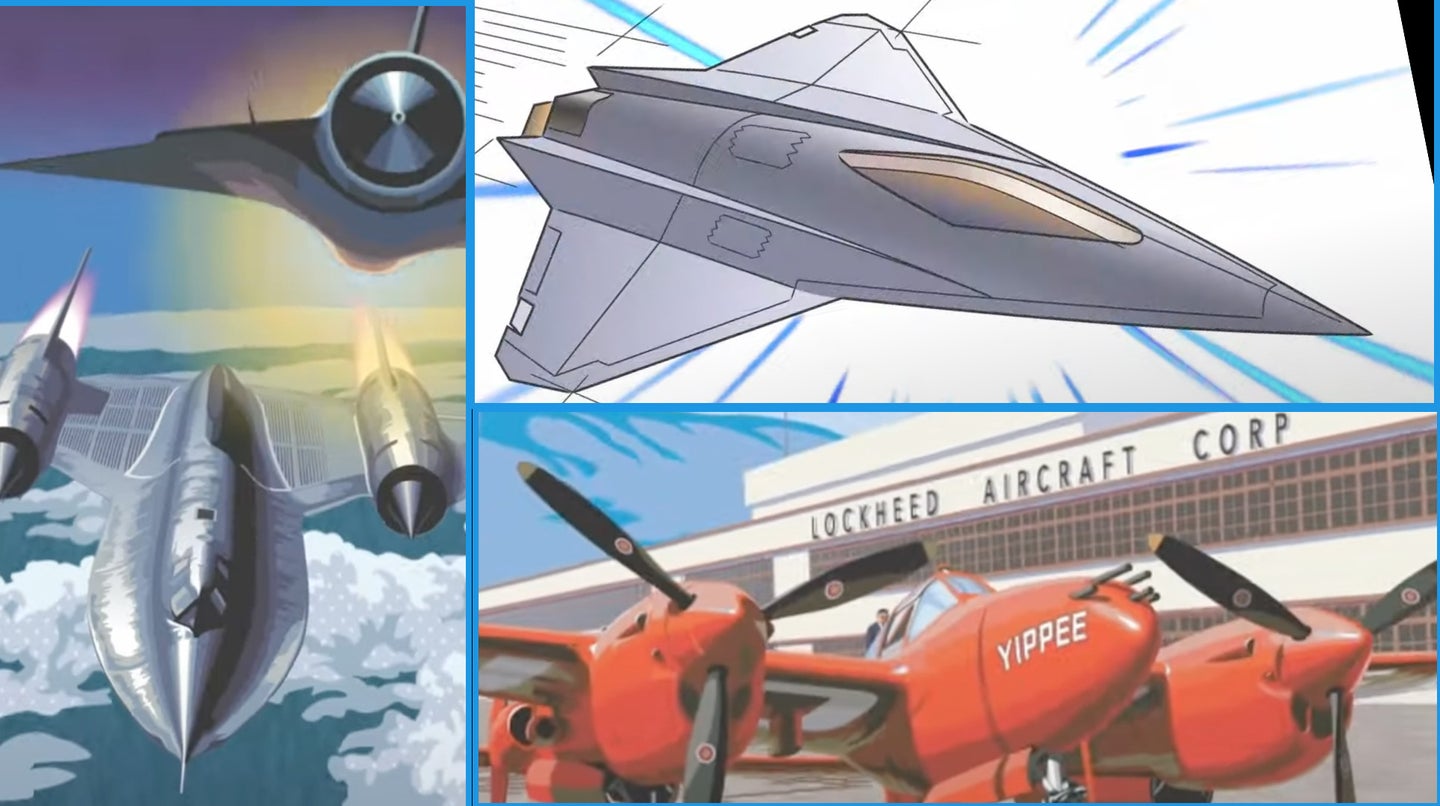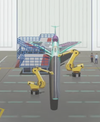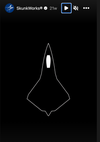Here are all the airplanes and easter eggs in the amazing Skunk Works video
How many easter eggs can you spot?

The Skunk Works is the most famous airplane builder on earth, which is a little ironic for a factory that builds top secret planes.
But long ago revealed as the engineering shop behind the U-2, SR-71 Blackbird, F-117 stealth fighter, and dozens of other groundbreaking planes, Lockheed Martin’s Skunk Works is today as famous as any commercial aviation company, with nebulous marketing deals with supercar-builder McLaren and a twin-Blackbird museum just outside the gate.
Founded 80 years ago by legendary aircraft designed Kelly Johnson, the Skunk Works began as an unremarkable hangar in Burbank, California, then rotated through a series of workshops-slash-hiding spots that included an abandoned distillery (there were still barrels of booze on the factory floor) and a giant circus tent under which Kelly and his engineers built the P-80 Shooting Star (more to come on that.).
As a final commemoration of the factory’s anniversary year, Lockheed released a new video in November that celebrates 80 years of Skunk Works projects. The 30-second animated video (which for some reason repeats three times on its YouTube posting) zooms through a series of curtains, doors, and scenes to “reveal” the history of the factory.
It is chalked full of both iconic airplanes and video easter eggs of Skunk Works’ often-secret past. Take a look here and then read on for our cheat sheet to what you might not have noticed:

In an email to Task & Purpose, Lockheed identified all the planes on the video and insisted that several of the mysterious ones are just “written concepts” of already-announced future programs, not actual ‘reveals’ of secret machines.
You can believe that if you want.
Here is our cheat sheet for the aircraft and easter eggs of the Skunk Works’ 80th Anniversary video.
Kelly Johnson, Burbank, and the P-38

The video begins with an image of Johnson himself — who famously wore black suits and dark glasses that we today would call aviators — outside the original Burbank factory, with the nearby-Verdugo mountains correctly placed in the background. The video quickly zooms out to a P-38, the twin-boom fighter designed by Kelly and his team that dominated the skies of the Pacific during World War II (its report card in Europe was more mixed).
Easter egg: The aircraft pictured is bright orange and with “Yippee” written on its nose, the name and livery of the 5,000th P-38 produced by Skunk Works in 1944. “Yippee” was also written across the bottom of the plane, so as to be visible from the ground, which you can just make out in the video.
P-80 Shooting Star in a big tent

The P-80 was the U.S.’s first jet fighter, delivered by Skunk Works in 1943. Several early copies were shipped off to Europe at the tail end of World War II, but the plane never saw combat there. It did, however, usher in the jet age for the Air Force and eventually went through extensive testing flown by Chuck Yeager.
Easter egg: The wartime project was so rushed that Kelly and his engineers did some of the development in a giant tent outside the Skunk Works factory. The striped tent in the video is the company’s best guess of what it looked like.
“It is an artistic representation of what the tent could have looked like that Kelly Johnson and his team worked out of while building the XP-80,” a spokesperson said in an email to Task & Purpose. “It is based off of the minimal historical imagery (B&W) that we have of the striped tent. We took an educated guess that it was red and yellow/faded white stripes.”
XF-90 and the F-104 Starfighter

As we leave behind the tent and Burbank, two planes come into view — the XF-90 and, taking off overhead, the F-104 Starfighter. The XF-90 was the Skunk Works follow-up to the P-80, with a longer range and more power but of a similar design. The F-104, however, was a total transformation in Skunk Works’ philosophy, with stubby wings built around a massive engine meant to outrun and out climb enemy jets, if not out maneuver. It was the first production jet to reach Mach 2 and 100,000 feet under its own power. It set speed and climbing records not broken until, well, another Skunk Works product a bit farther down this list.
Easter Egg: While the F-104 flew for close to two decades in the U.S. Air Force (and longer with foreign air forces), only two prototypes of the XF-90 were built, as the plane’s production — like the plane in the video — never got off the ground.
SR-71 Blackbird and the D-21

The SR-71 needs no introduction or hyperbole. A wraith of still-unmatched supersonic engineering, the SR-71 was built to outrun Russian missiles and super-jets which themselves were built to shoot it down.
The Blackbird always won, 4,000 times in a row, according to Airman Magazine.
Built of titanium, its body leaked fuel until it reached cruising speeds beyond Mach 2, speeds which heated and expanded the titanium enough to stop the leaks. Capable of speeds beyond Mach 3, it once flew from LA to DC in 64 minutes — roughly as fast as a bullet fired from a modern M4 rifle would make the trip if it left the barrel and never slowed down.
Flying formation with the SR-71 is the D-21 drone, an unmanned reconnaissance aircraft built to fly as fast as its bigger brother with no risk to pilots. While Skunk Works clearly understood how to make fast planes, not even their engineers could make the unmanned plane work right, five decades before the first large military drones came online. The program was scrapped after four failed flights over China.
Easter Egg: The D-21 is shown pulling up and away from the SR-71, a rough recreation of how the D-21 actually worked. In its original design, it was launched in mid-flight by a larger SR-71-like mothership known as the M-21. A fatal accident during flight testing convinced the Skunk Works to redesign the D-21 so it could be launched from under the wing of a B-52.
Stealth and “Fifth Generation”: F-117, F-22, F-35

From the first biplanes of World War I through the Vietnam War era, air superiority has always come down to speed, power, and the accuracy of a fighter’s weapons. But in the 1980s, with Mach 2-plus jets in service around the world carrying long-range missiles that could kill an opponent before the pilot could see them, Skunk Works ushered in the Stealth era with the F-117 Nighthawk. Smaller and slower than a traditional fighter but built to be invisible, the F-117 participated in the 1989 invasion of Panama and was revealed to the public for its role in the 1991 Gulf War, when Soviet-made systems used by the Iraqi army literally never saw it coming.
The low-visibility technology of the F-117 flies today in Lockheed’s two “Fifth Generation” fighters, the F-22 and F-35. The jets are widely dubbed “Fifth Generation,” because, well, Lockheed long ago trademarked that term to slyly imply that fighters like the F-15 and F-16 belonged to a “fourth generation” of jets that were suddenly surpassed. But the modern Skunk Works fighters do share the DNA of the Nighthawk, built not just to be fast and maneuverable, but also with stealthy features, from carrying weapons internally to reducing radar signature to high-tech, non-reflective coatings and materials on their skin.
U-2 and Senior Glass

First flown in 1955, the U-2 was, in some ways, the first spaceship, flying high enough that pilots needed fully pressurized suits we would today recognize as space suits and returning photos of the curvature of the earth. With massive wings, it could loft to an altitude well over 70,000 feet, well above the missiles and jets of the 1950s.
But at that altitude, pilots found themselves in what they called the “coffin corner,” the nickname for the tiny slice of aerodynamic laws in which the U-2 could fly — just barely — without breaking apart. Cruising at about 470 mph at 70,000 feet, pilots had to hold the jet within 10 mph of that speed. If they went 5 mph too fast, the huge fragile wings could break apart. But at those near-space altitudes, the air is so thin that flying just 5 mph slower would put the plane into a likely fatal stall.
Senior Glass Easter Egg: While the U-2 originally flew over Russia and other targets with a film camera that pilots had to activate while flying, times have changed. On top of the U-2 in the Lockheed video is a pod known as the Senior Spur or Senior Span data link, which beams the U-2 intelligence haul — pictures, signals, video, whatever else it’s looking for — to satellites above for instant analysis back home. The pods under the wings carry the Senior Speer and Senior Ruby intel sensors, collecting communications and other electronic signals. Together, the systems are known as the Senior Glass suite.
Lockheed’s spokesperson would not confirm if the green lasers, which connect to other planes in the video, were specifically meant to represent those particular spy systems. “No particular system, it is just a representation of a distributed team,” Lockheed told Task & Purpose.
SeaGhost and RQ-170 Sentinel

Skunk Works UAV programs represents something of a breakpoint in the Skunk Works inventory, where secrecy and public information meet. Our friends at The War Zone pointed out that image in the video appears to be a conceptual drawing of the Sea Ghost, Lockheed’s never-built prototype for the Navy’s UCLASS program, or Unmanned Carrier-Launched Airborne Surveillance and Strike vehicle. Its general bat-wing shape and stealthy curves are thought to be based on Lockheed’s latest fully operational — though still mostly secret — UAV, the Air Force’s RQ-170.
The Air Force acknowledges that the RQ-170 exists and is flying, with a ‘fact sheet’ on the Air Force website that says it’s based at Creech Air Force Base, Nevada, and the Tonopah Test Range — the secret testing facilities that make up the mythical Area 51. But almost nothing else is known about the RQ-170, including where and when it deploys and most of its capabilities. The War Zone absolutely loves chasing the RQ-170, digging up secret pictures, accidentally released information, and even satellite photos of the elusive spy drone.
Among its deployments that TWZ and others have dug up include Afghanistan, South Korea, and Crimea, where it is thought to have spied on Russian defenses in that country’s war with Ukraine.
In 2011, the RQ-170 was hacked in mid-flight by Iranians, who commandeered the plane as it monitored Iranian nuclear activity.
Easter Egg: Perhaps the best information available on the true size of the RQ-170 comes not from the Air Force, Lockheed, or any intrepid plane spotters or spies. Instead, the U.S. Army listed the secret drone among hundreds of planes in its aircraft spotting manual in 2017, revealing it to be 66 feet wide and over 14 feet long.
X-59 QueSST

Unlike the spy planes and fighter jets above, the X-59 is an experimental project between Skunk Works and NASA, searching for a design that can efficiently fly past Mach 1 without a massive sonic boom. The goal is to create technology that can allow airliners to fly faster than the speed of sounds, something no commercial plane has done since the retirement of the loud, cramped, and economically unviable Concorde. The X-59 hasn’t flown yet, but it’s expected to drastically reduce the sonic boom that planes produce as they fly faster than the speed of sound. Sonic booms, famously, can sound like massive explosions, even shattering windows. The X-59 boom — thanks in large part to its long, flat, duck-bill-like nose, is expected to produce a boom that sounds more like a car door closing.
Easter Egg: So where in the Skunk Works factory are we getting a sneak peek of in the X-59 portion of the video? What kind of wild, futuristic, completely gonzo secret robot machines are those two yellow arms? Well, Lockheed didn’t say, but, the answer may not be that exciting: according to a recent Lockheed release on the X-59, the plane is currently in the factory’s paint barn, a final step before it can begin flight tests.
The rumored X-?, the elusive F-?? and the never-confirmed RQ-??

The final three images in the video are the fun ones, not real planes but three comic-book-style drawings that range from suggestive shapes to rumored designs to mystery crafts.
According to Lockheed, “the last three are just written concepts for Hypersonic, ISR/UAS [and] Future Fighter,” according to a spokesperson.
That leaves much to speculate about.
“Hypersonic” is an all-the-rage buzzword in aviation that generally refers to flying at least a mile per second, or about Mach 5, a speed far beyond the ability of modern defensive systems to intercept. Skunk Works and other defense builders have been working on hypersonic missiles and drones for more than a decade, including the DARPA FALCON program. The program’s HVT-2 flew between Mach 22 and Mach 17 for over two minutes in 2010, a speed almost as fast as the International Space Station, and which could cut down the SR-71’s LA-to-DC record to about 10 minutes. There are other hypersonic names in Skunk Works mythology, including the rumored SR-72, which could be ‘possibly a drone’ or ‘optionally crewed’ or a plane like the Darkstar in Top Gun: Maverick (the onscreen design for which was developed with Skunk Works help), which may be based on the Aurora, a hypersonic jet whose existence has been rumored — but unconfirmed — since the 1990s.
In other words: there are lots of rumors, theories, and blurry pictures about hypersonic airplanes, but precious few facts, and Lockheed’s circles-and-cones sketch on the video offers no new hints.
However the “Future Fighter” is much more real. Specifically, this picture is likely to be Lockheed’s entry in the Next Generation Air Dominance Fighter, or NGAD. As the F-15 and F-16 were the flying stars of their day and the F-22 and F-35 roam the skies today, the NGAD will be the fighter jet of tomorrow. Skunk Works is one of several companies currently competing to build it. The picture in the video is not particularly technical but matches the shape Lockheed has put out on its Instagram, of all places, as being the likely look of its entry in that race.

As for the final image of a drone-like craft, Lockheed told Task & Purpose it was “ISR/UAS,” which stands for “intelligence, surveillance, and reconnaissance” and “unmanned aircraft system” — not exactly catchy or particularly secret. The drawing caused some buzz on social media, with distinctive notched exhaust ports on the rear of the otherwise RQ-170-like shape.
Update, November 30: This story has been updated with information on the Sea Ghost and RQ-170 UAV.
The latest on Task & Purpose
- End of an era: The last class of Marine Scout Snipers graduates on Dec. 15
- That one scene: The most unrealistic part of ‘Rambo: First Blood’
- AC-130 destroys truck after watching it launch ballistic missile at US troops in Iraq
- Army veteran launches ‘Hots & Cots,’ a Yelp for enlisted life
- Trench warfare tips: What US troops need to know from Ukraine
